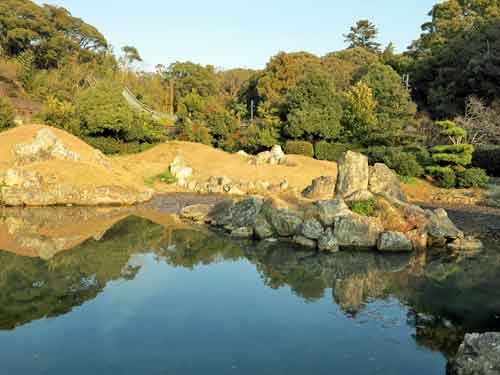Zoen Japanese Landscaping Gardens
Zoen Japanese Landscaping: the various elements of a garden, including trees, stones, grasses, sand and moss, all have distinctive meaning as symbols.
Zoen Japanese Landscaping in Traditional Japanese Gardens 造園
The basic techniques that are used for creating and maintaining traditional Japanese gardens were first developed during the Heian Period in Kyoto, which has an ideal climate for growing garden trees, a high concentration of special rocks and sand as well as an abundant water supply. At first gardening was an exclusive art practiced by priests, the aristocracy and warriors. The art spread to the merchant class, in the form of tsubo-niwa, during the latter half of the 16th century. The tsubo-niwa gardens of Kyoto were influenced by the tea ceremony. Built between homes, they serve to improve lighting and air circulation.
The various elements of a garden, including trees, stones, grasses, sand and moss, all have distinctive meaning as symbols. The delicate balance of these elements is determined by considering the light and soil conditions. Gardens are then planned and laid out on paper to visual perspective and elevation. The first step in garden design is building the foundation to provide drainage so that the roots of trees and plants do not rot. At this time, ditches for such underground facilities as electrical equipment and water supply systems are also excavated. After completing the foundation work, the garden rocks, trees and shrubs, and related sodding are positioned according to the design plan. Lastly, decorative moss, other plants, and gravel are placed or spread out over designated areas. The Kyoto Prefectural Landscape Gardening Cooperative Association The Kyoto Prefectural Landscape Gardening Cooperative Association, with about 350 members (individuals and companies), has been active in preserving Kyoto gardens and transmitting landscaping skills and knowledge to new generations for nearly 100 years. Over the past 45 years, Japan's traditional landscape gardening industry has suffered a severe downturn in business, and the total number of new gardens handled by association members has been steadily decreasing. Today, more than half of an average Japanese gardener's work involves maintenance. Gardens take a considerable amount of time to mature and once a garden has reached maturity it requires special skills to maintain it according to its original design. Until only quite recently, the special skills of Japanese landscaping were passed on from generation to generation. Today, the number of garden businesses is decreasing. To keep Japan's age-old gardening skills alive, the Association has set up a special one-year intensive gardening school to train apprentices. Naturally, Kyoto is the perfect place to study this art; the city is home to most of Japan's most famous gardens. This year, the school has 32 students, half of whom are from outside Kyoto.
Japanese landscape gardens have become very popular internationally. The Association designed a large-scale garden, modelled on the famous garden at Daigo Temple's Sanpo-in, in Kyoto's sister city in Mexico, Guadalajara. Employing Mexican workers and under greatly different climatic conditions, the project took nearly two years. The Association also created a Japanese garden for a private residence belonging to Prince Charles, in England. As a gift of friendship between the US and Japan, a number of young gardeners in the Association were employed to build a garden in Oklahoma. The Association is also active in working with the international Japan Garden Society, which visits Kyoto annually.











